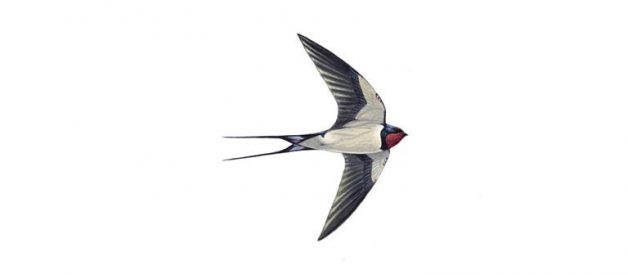Discovering the Answer to a Monty Python Classic

Well, the most obvious answer- you might think- is ?An African or European swallow?? But this is, indeed, where film culture begins to diverge from real life. Because in actual fact, none of the 47 swallow species found on the continent directly bears its name. We might consider the West African swallow, or the South African Cave swallow, however a choice between these two would be completely arbitrary- and neither is sufficiently studied to provide the data we need.
So we shall answer our first question, and go simply for the European (or ?Barn?) swallow. And this is where things get a little science-y, so buckle up! Believe it or not, there is in fact an accepted way to estimate the airspeed of a bird using an equation known as the Strouhal ratio. This states that the frequency of wingbeats multiplied by their amplitude and divided by the airspeed of the bird provides a semi-constant value. This is known as the Strouhal number and averages between 0.2 and 0.4 for most birds, with a higher number denoting a less efficient flight pattern.
When I said that the European swallow was well studied? well, I wasn?t joking. Because it turns out that a 50+ year study run by the University of Cape Town has captured, measured and released 25,000+ of these birds. And with the benefit of this data we can very easily discover their average mass and wing-length- 20.3g and 0.122m (12.2cm) respectively.
The amplitude and frequency of such birds in flight has unfortunately not been studied quite as extensively, so here?s where the guesswork comes in. However, by comparing the above values to similar birds, we can come up with an estimated value of both measures. The frequency calculated thus turns out as 15 wingbeats per second, the amplitude of each stroke being 22cm.
Now for the exciting part!! Swallow flight is (for those poor people who have failed to watch it) clearly very efficient, seeming almost effortless. So we?ll opt for the lower end of Strouhal numbers in our working, giving us (drumroll please), an airspeed velocity of 11?16 metres per second. That?s 40?60 kilometers per hour? pretty fast!
So how did we do? It turns out that one study has indeed been conducted that directly analysed these birds? flight, and their results are pretty interesting. Recording two swallows flying through a wind tunnel in Sweden (minus the wind), they showed that wingbeats occur at a startlingly low 7?9 beats per second. That?s rather a lot less than the 15bps we guessed at- and Monty Python?s guard pinning it at 43bps was in a whole other ballpark!
In the end though, our answer was pretty darn good: their max speed clocks up at 14 metres per second, averaging out at 8?11 for normal flight. The reason, of course, is that a swallow?s flight is even more efficient than we had given credit for: blowing its avian counterparts clean out the water with a shocking 0.13 on the Strouhal scale.
With a coconut? Well, the somewhat inaccurate guard gets the gist of the matter across here: ?A five ounce bird could not carry a 1 pound coconut.? Except that a swallow weighs 0.7 oz and the coconut clocks in at 1.5lb (24oz). So yes- once you manage to carry a minibus on your back and run a marathon, then perhaps you can start talking to that swallow. But if you could hook 500 of the birds up in one line??


